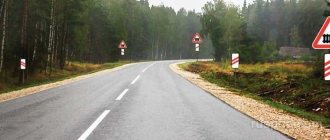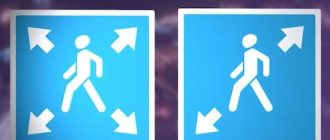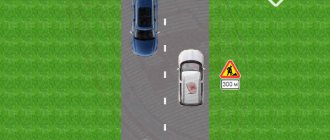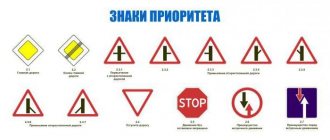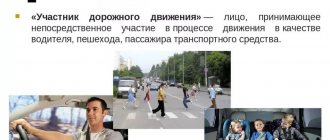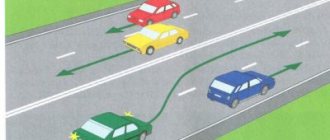Good afternoon, dear reader.
Traffic rules regulate the order in which vehicles move on the roads. One of the main issues that traffic rules solve is which of the traffic participants can pass first in a given situation, that is, who has the advantage.
This article discusses the penalties for failure to provide an advantage:
- pedestrians;
- special transport;
- a car at an intersection;
- a car in other cases;
- table of penalties.
Advantage (priority)
An advantage in traffic regulations is a right and a principle that can only be applied within the framework of real traffic. And traffic rules regulate priority issues with one goal - to streamline road traffic and ensure maximum safety for its participants.
The purpose of the Rules is to regulate the activity of all traffic participants in such a way that their activities, on the one hand, fit into some kind of harmonious system (and this is road traffic), and on the other, would not lead to an accident.
Definition from traffic rules (clause 1.2):
“ Advantage (priority) ” - the right to priority movement in the intended direction in relation to other road users.
If we simplify this definition, then a person or vehicle that has priority (or advantage) can carry out its plans before others - pass, pass, turn, etc.
Let's look at the most typical examples of priority.
1. Pedestrians crossing the roadway (or tram tracks) at an unregulated pedestrian crossing have priority.
Unfortunately, violation of this principle very often leads to terrible, monstrous consequences.
That is why special rules for passing pedestrian crossings are highlighted in a special section of the traffic rules (section 14).
2. The tram has priority in cases where the tram tracks cross the roadway outside the intersection (except when the tram leaves the depot).
Ignoring by drivers of this principle of advantage or even elementary inattention of the driver when traveling on tram tracks also leads to serious accidents.
In general, rail vehicles require increased attention.
3. Special vehicles with special signals (sound and light) performing an operational mission have an advantage.
The duty of the ordinary driver and pedestrians is to give them the right of priority.
4. A route vehicle that leaves a designated stop in a populated area has priority.
By the way, this rule is very often ignored by drivers who, either unknowingly or intentionally, do not notice minibuses pulling away from a stop.
We have considered a far from complete list of cases when a certain circle of road users has an advantage over other subjects. And, as Russian practice shows, the principles of advantage (or priority) are often violated. And an accident becomes an unpleasant, but natural result of this violation.
So, priority is the unshakable right of the driver of a vehicle or pedestrian to perform the intended actions first. The most common advantage granted to a driver by the Rules is being on a main road.
the main road
The main road is the main, most common concept that a driver encounters in traffic.
Looking ahead, let's say that when moving along the main road, the driver has an advantage over those participants who are not on it.
Definition from traffic rules (clause 1.2):
“ Main road ” - a road marked with signs 2.1, 2.3.1-2.3.7, 5.1, in relation to the one being crossed (adjacent), or a road with a hard surface (asphalt and cement concrete, stone materials, etc.) in relation to the dirt road , or any road in relation to exits from adjacent territories. The presence of a paved section on a minor road immediately before the intersection does not make it equal in importance to the one it intersects.
Quite a capacious and complex definition. Let's try to break it down into its components in order to understand and understand the main examples of the main road. But first we note one thing: the main road can only be such at some intersection. Otherwise, it is nonsense: a road can be recognized as the main one only in relation to some other road - which is not the main one at the intersection!
1. The main road is marked with special signs.
The easiest way to determine the “main” of the road is to see the following road signs on your way through the intersection.
In other words, when driving through an intersection under the indicated road signs, the driver will have priority over those traffic participants who enter this intersection from a secondary road.
However, the driver should not forget: at any intersection there is - at least! – two entrances to the main road. And the priority of any of the “main” participants is determined by other sections and principles of the traffic rules.
2. The main road is a paved road in relation to a dirt road.
This rule is actively used in practice when crossing roads with field, forest and other roads, which are not always advisable (at least from an economic point of view) to provide such intersections with priority signs.
This is where it’s important not to make a mistake! Paving stones and rubble stone are also hard surfaces. Just like asphalt! And a road paved with brick, concreted, lined with reinforced concrete slabs will be equivalent in relation to the asphalt section of the road. It's all hard surface! And, therefore, the specified priority rule will not work here.
Roads with different hard surfaces will be of equal importance.
And here's another thing! A small “eye” of asphalt at the border of the intersection with a “hard” road does not make the primer equivalent.
The notorious “eye” was created specifically so that the driver, leaving the dirt road, stops on the asphalt area and cleans the wheels of his car from dirt and other attributes of the unpaved surface adhering to them (so as not to carry all this dirty tricks onto the highway).
3. The main road is the road in relation to any exits from any adjacent territories.
Let us remember that the adjacent territory is the territory that is directly adjacent to the road. And such areas are considered to be courtyards, gas stations, parking lots, etc. We also know that exits from the adjacent territory are not considered intersections.
Now it is important to remember that at intersections associated with such exits, the main road will be any road on which drivers leave from adjacent territories.
And this rule works regardless of the installation of priority signs at such intersections.
Thus, the main road can be designated in three ways:
- priority signs indicating the right of way and the “Motorway” sign (5.1);
- the ratio of the paved road (main) to the dirt road (secondary);
- the relationship of the road (main) to the exit from the adjacent territory.
What to do if there are no signs
Let's look at the following situation. There are no priority signs on the driver's side.
Then it makes sense to refer to paragraph 13.13 of the traffic rules.
It says the following. When a motorist is unable to determine the surface and there are no priority signs, he should assume that he is driving on a secondary route.
The inability to determine the coverage is determined by poor lighting, the presence of snow, dirt, etc.
It turns out the following. When the driver cannot determine the status of the road, then you need to act on the basis that you are on a secondary route. And if sign 2.4 is visible ahead, but is turned backwards, then when crossing this road will be the main one. There are no options here.
The priority should always be to assess vehicles that are on a potential main road. See how many there are and how far they are from you. They have an advantage. Therefore, if vehicles are close, you will need to let them through.
As for oncoming cars, you have equal rights. After all, both cars are moving on a secondary road. What follows from this? If the car opposite is about to turn left, then first it must let you pass, moving straight.
There is just a nuance. Use priority only if you are sure that the oncoming vehicle intends to yield.
Give way
The flip side of priority is the requirement to give way. The logic of movement is precisely determined by the simultaneous requirement for drivers to either take advantage of their advantage or give way.
Definition from traffic rules (clause 1.2):
“ Give way (do not interfere) ” is a requirement that means that a road user must not start, resume or continue moving, or carry out any maneuver if this may force other road users who have priority over him to change direction. movement or speed.
Despite the cumbersome definition, it is not at all difficult to understand. A traffic participant who is obliged to give way must do everything possible and necessary to ensure that through no actions he creates interference with a traffic participant who currently has priority.
A very common case: giving way to a pedestrian at a pedestrian crossing. This is a sacred thing!
Note that traditionally drivers associate the concept of “giving way” with the concept of “letting pass.” This is not entirely correct, but very close to reality at the applied, practical level. In reality, the “Give way” requirement is quite insidious. It does not mean an unconditional requirement - be sure to stop and let the priority traffic participant pass, faithfully watching how he drives or passes by. This is a very subtle matter, but you need to understand it.
Giving way is a requirement not to interfere with the participant who currently has priority. And if by our actions we cannot create these same obstacles, then we have the right to continue performing the action we have planned (maneuver, movement, etc.).
To demonstrate this statement, we give several examples.
Example one.
A truck driver on the main road is about to turn left, and we are about to turn right. Our trajectories – in principle! - do not intersect. Therefore, we can continue driving without interfering with the truck. In this case, we will comply with the requirement of the “Give Way” sign, but only after making sure that we do not interfere with it.
Example two.
The driver of a car is about to start driving. His duty is to give way to vehicles already moving on the roadway. But the truck is moving in the second lane, and the driver of the car will not interfere with it through his actions. Basically! That is why he can start moving, because he will not violate the requirement - to give way to the truck.
Example three.
The motorcyclist, judging by the road signs, has the right of way on the narrow bridge. However, there is a high probability that, driving along this narrow section of the road at the same time as a motorcyclist, we will not make it difficult for him to move (due to his small dimensions). Basically! Therefore, having made sure of the last circumstance, we can drive onto the bridge in parallel with the motorcyclist. But just without interfering with him!
And one moment. For many drivers, the concept of “Give way” is associated exclusively with the priority sign of the same name – “Give way”.
In fact, this concept is much broader. As well as much broader issues of priority, which are not limited to the “Main Road” sign. It is important to remember that the presence of an advantage for one participant in the movement automatically means a requirement to give way (that is, not create interference) for other participants.
This is the logic of accident-free traffic!
Traffic light.
The next important priority on the road is the traffic light. If, approaching an intersection, you see a working traffic light (and there is no traffic controller standing there), we act according to his commands. Everyone knows the golden rule from childhood:
"If the light turns red,
This means it is dangerous to move.
Green light says:
“Come on, the way is open”!
Yellow light warning,
Wait for the signal to move.
What does a flashing green traffic light tell us? There will be no definite answer here; everything will depend on the specific road situation. But I recommend the following algorithm: if you are driving straight and the traffic light starts flashing when you have almost approached the stop line - press the gas! It's gas! We don’t start fighting with our thoughts: stop, or pass, I’ll have time, or slow down... Because we need to get through the intersection as quickly as possible. After all, now it will change to red, there will be a stream of cars crossing our trajectory and an accident may occur.
What to do if you are about to make a turn, and it doesn’t matter whether it’s to the right or to the left? In this case, I recommend stopping even if the traffic light starts flashing just before the stop line. Before turning, we always slow down, our speed is lower, so we will complete the maneuver on red, and the crossing traffic will already begin to move on green.
By the way, the largest percentage of accidents happen at intersections, when someone was driving on a flashing green light, and someone else started driving on a yellow one...
Sometimes near the main traffic light on the road we can see an additional section, or just a sign with a green arrow. We can consider both the section and the arrow as a “give way” sign. Movement in the direction of the arrow is allowed, but only after cars have passed through the main traffic light.
There are a number of other important points when passing additional sections of traffic lights and signs with a green arrow, but I will write a separate article about them. For now we will limit ourselves to this information.
Right hand rule
There is no such rule in the traffic rules. More precisely, it exists, but precisely such a concept does not exist. This is an invention of the drivers themselves, traffic rules teachers, practical driving instructors - the “right hand rule”, “take care of your right side”, “interference on the right”. And this rule sounds like this: you must give way to obstacles on the right.
Rule from the traffic rules (clause 1.2):
In cases where the trajectories of vehicles intersect, and the order of passage is not specified by the Rules, the driver to whom the vehicle is approaching from the right must give way.
Unfortunately, ignorant drivers apply this principle left and right, regardless of the requirements that apply to this rule. But in vain! The right-hand rule has conditions under which it works (and under which it cannot and should not apply).
Let's look at this rule in more detail.
Let's imagine an intersection that is not marked by either priority signs or traffic lights. And the traffic controller didn’t have time to get here either. How can vehicles pass each other at such an intersection?
According to the “right hand” rule! A driver who has an obstacle on the right must give way to this obstacle. It’s easier to skip it!
When can we apply this rule?
1. The order of travel should not be specified in the Rules.
This is a fundamental requirement: the actions of drivers driving according to the “right hand” rule should not be regulated by other traffic rules. Only in this case can this principle of priority be applied.
2. Participants in the movement must be equal.
Thus, it is impossible to apply the “right hand” rule in the system of relations “pedestrian – vehicle”.
Also, this rule cannot be applied in the “tram – trackless vehicle” system.
These relationships are regulated by the Rules, therefore the “right hand” rule cannot be applied to them.
And one moment. This rule is universal; it can be applied in any situation, but subject to the two conditions discussed above. And, of course, the trajectories of movement must intersect.
A simple check of the drivers' KBM using the AIS RSA database for compulsory motor liability insurance in some cases will help you get a discount when applying for a policy.
How to pay for parking in Moscow by SMS or other methods.
Check light in the car possible causes.
Reader Questions
In front of the narrow section there is a sign 2.7, which gives an advantage, but next to it there is a 2.6 on a yellow background, obliging you to pass. Which one should be met?
Answer: According to Section 8 of Appendix 1 to the Traffic Regulations, in the repair work area, sign 2.6 can be painted on a yellow background. It is temporary. If contradictions arise between the meanings of temporary and permanent indicators, the driver should be guided by the temporary ones.
Can a motorist not give priority to the opposite participant if the 2.6 indicator is installed?
Answer: According to clause 2.6 of Section 2 of Appendix 1 to the Traffic Regulations, the advantage of oncoming traffic means that a motorist is prohibited from entering a narrow area if this creates interference or danger for the opposite flow. For example, there is a motorcycle on one side and a car on the other, and the width of the roadway allows them to pass each other with a sufficient minimum lateral interval - in this case there is no need to give way. If simultaneous passage is difficult, the one on whose side there is a sign with the corresponding instructions gives way.
Who gets priority if there is no signage in a narrow area?
Answer: According to clause 11.7 of the traffic rules, if the order of passage is not established, the one on whose side the obstacle is located should give priority. Traffic regulations do not provide for a procedure if passing is difficult solely due to insufficient width of the roadway. Drivers must pass by mutual consent. The exception is driving uphill, in this case the motorist moving downhill yields (Section 11.7 of the Traffic Regulations).
Oncoming traffic on narrow sections of the road is carried out in accordance with signs 2.6 and 2.7, indicating the side obligated to give priority. In their absence, drivers should be guided by the general rules of priority according to traffic rules: the one on whose side the obstacle is on, or the one who is moving down the slope, indicated by signs 1.13 and 1.14, gives way. Violation of the driving rules is an administrative offense (12.15 Code of Administrative Offenses of the Russian Federation), for which a fine of 1,500 rubles is provided.

